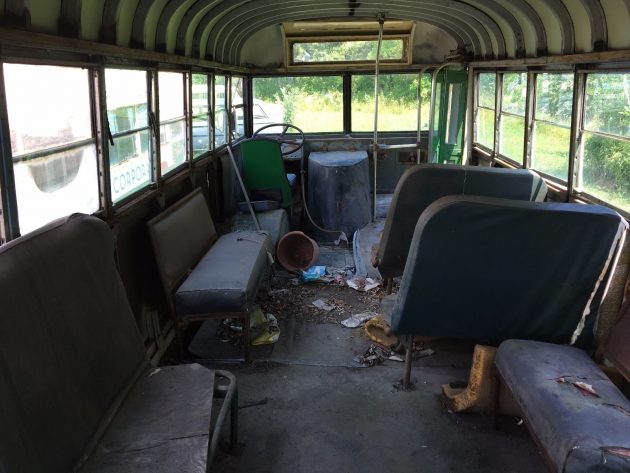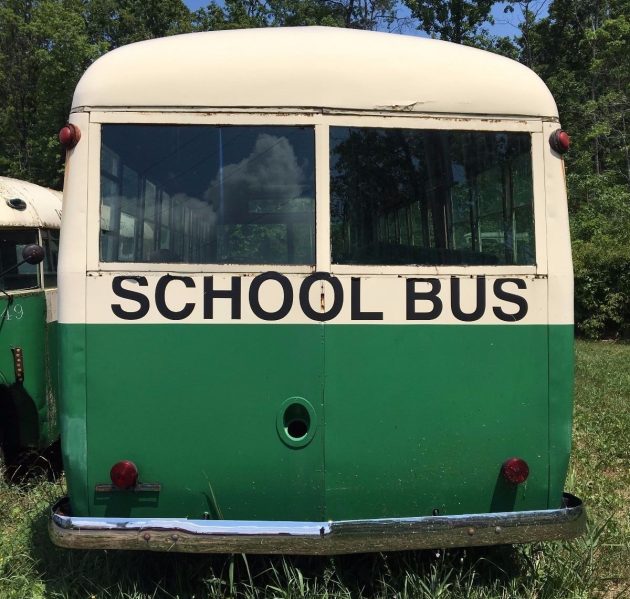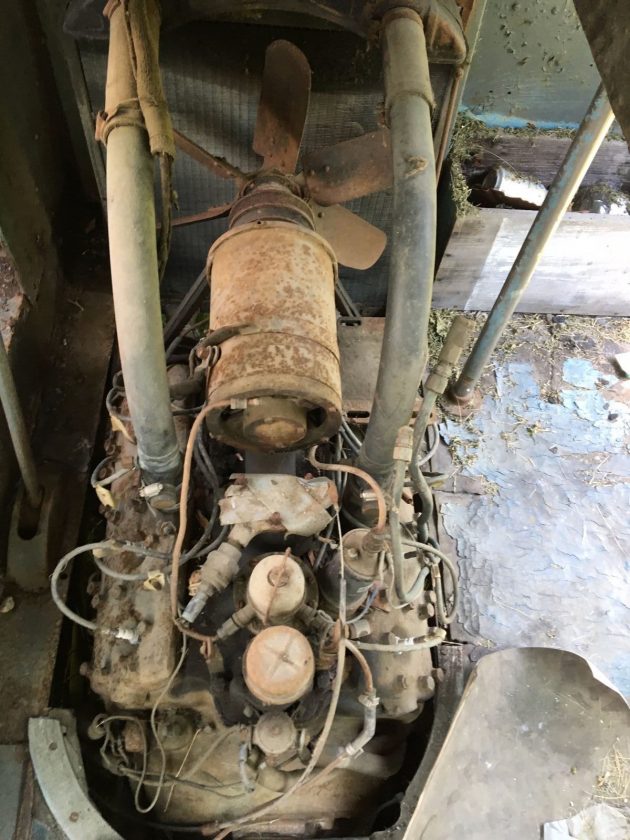Ford built about a thousand of these forward control transit buses from 1936 until 1939. In 1939 the engine was moved to the rear for better weight distribution. Ford built about 12,000 of these, also know as cracker boxes until 1947. They were used in the transit systems of many cities from Seattle to New York. This front engine bus is listed on eBay for $6,500. It’s very original and complete and located in Saugerties, New York.
There’s no luxury here. It does appear original and complete though. Imagine all the animals that have called this bus home.
The back door was probably replaced by the wood panel when the bus was converted into a school bus.
There was no rear emergency exit, or any emergency exit at all.
That’s an 85hp, 221-cubic-inch Ford flathead V-8 engine. It turns but no attempt has been made to start it.
People have come up with lots of interesting uses for old buses. These cracker boxes do have a unique look and there are few remaining. It would be interesting to see what uses could be found for it. I don’t think this could be made very comfortable for long trips but it could be a nice driver. There are lots of places where this would make a very unique shuttle bus.








Oh wow. A flathead pulled that thing? One could make it a nice rv but a power upgrade would be in order. The design seems more like a modern bus then the ’55 at the bottom of the page.
Great business
I’d say take it to your favorite city, paint it to match the city’s 1939 transit system, great for parades.
I would say power tour or RV but let’s face it, in order to drive it that much you’d have to totally change it.
It would also be cool for a park or Ghost Tour.
funny how modern it looks, yet with that small flathead it would be restricted to slow moving city traffic. it should be restored and used as a tourist bus.
I agree. Looks really modern for something built in the late 30’s.
Bet those flatheads overheated like crazy!!
They were modern looking for their time. No wonder they earned the nickname “cracker box”. Later in 1939 when Ford switched to a rear engine, these Ford busses toook on an even more modern appearance. Even at the end of production in 1947 they still looked modern.The model 91 introduced in 1948 dis not look that different and transit busses retained the “cracker box” look through the 1950s.
To be clear, the word “Crackerbox”, to me and most other old ( crabby) truckers, ( that’s ok, I know who I am) conjures up images of the mid-’60’s GMC F model cab over semi tractor.( shudder) But that’s a story for another time. This bus is great, and only about 20 minutes from me. We go to an auction house every Friday in Saugerties.( about 2 hrs. N of “the city”) Great people in Saugerties ( New York in general, I’ve found) I suppose I could look at it for someone, but it’s pretty self-explanatory. Me? I’d do the camper thing on an modern drive-train. Cool bus.
Like Howard says, the term, ‘Crackerbox’ makes not only crabby ol’ truckers think of those short GMC and International Sightliners but makes grumpy ol’ mechanics think of them as well. However, most of us are willing to expand our horizons and allow something else into the fold. These hot and stuffy old buses will suffice.
Interesting that over the years I saw a few of this style bus but all of them were rear-engined. Just the same it would be a blast to restore something like this and convert it to a neat vintage-style camper. And yes, if you’re planning to put some miles on it, it wouldn’t hurt to swap in some more power. But that cantankerous old flathead would still add some fun(?) challenges to the average trip to the mountains…
i saw this bus in scotland ontario canada a few yrs ago. ttc toronto ran these till 1954
I just love that shift lever.
Check out those bumpers! Flathead truck motors must have been bigger than 221.
Hi tugdoc, I think you are right. Research on the Ford flathead V-8 shows, in late 1938 Ford introduced the 239 ( oh boy) with 91 hp (wow), but the 221 was still produced through 1942 for civilian use. I can’t see the front of the motor, but something to do with the location of the water pumps is how you can tell the difference.
Hi guys. Some clarification for the late 30s flatheads. You could maybe refer to this as the gospel (can still be disputed) according to Geo: The water pumps were actually lowered (from the heads) to the block in ’37. That was also the year that they incorporated the front motor mounts into the pump castings. The 78 (’37) was a 21 stud 221 cid motor (the 78 was the official V8-85). 1938 started out as a 21 stud and was identical to the 78 with the exception of 14 mm plugs vs 18 in the ’37 models. It also had a running change to 24 stud heads while still retaining its designation of ’81A’. Late ’38 (as you said, Howard) saw the introduction of the Mercury (99A) with 239 CID. The official ’39 Ford was branded ’91A’ and was actually difficult to tell the difference with the 99A other than the numbers cast into the heads. I’ve seen both 91A and 99A with indented numbers or raised numbers on the heads. I was told that there was a number stamped on the block next to the oil pressure sending unit but that doesn’t apply to all of them. The Mercury engine quickly became available on larger trucks and (I understand) buses. A lot of 221 motors were cast aside in favor of the 239. Now, the plan to scrap the 221 was in the works for a while because, sometime in 1941, the 11A motor was actually a 239 block that was sleeved down to 221.Get one of them, pull the sleeves and you’ve got an instant 239.
Hello everybody, I’ve been coming to this site for a few years but never seeing this page till now. I actually found it on a couple of other sites that were direct me to bring a trailer, and I realized quickly that it must have been posted here and just did a search for it and found it. Does anybody have any idea what ever happened to it? I don’t live too far from where I was supposed to really be sold from and I just wonder what ever happened. The original eBay page is gone so I couldn’t tell if it was sold or not. Did anybody ever go see it, or know where in Saugerties it was supposed to have been?